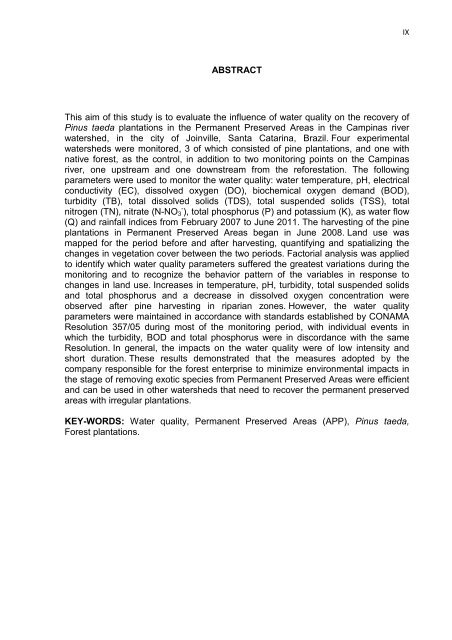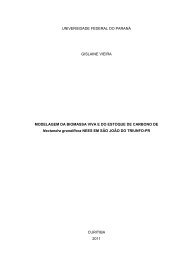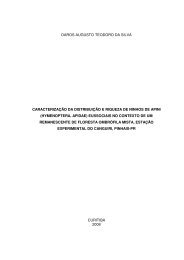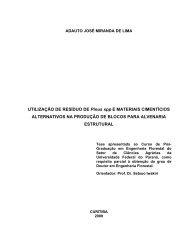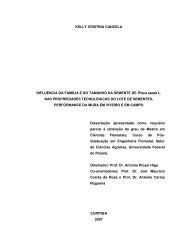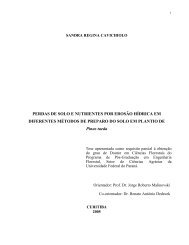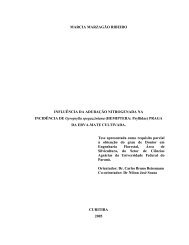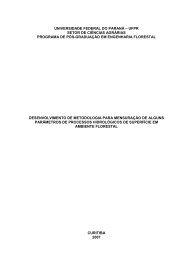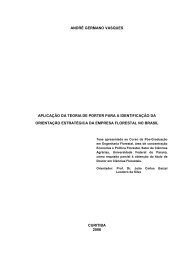Dissertação em PDF - departamento de engenharia florestal - ufpr ...
Dissertação em PDF - departamento de engenharia florestal - ufpr ...
Dissertação em PDF - departamento de engenharia florestal - ufpr ...
You also want an ePaper? Increase the reach of your titles
YUMPU automatically turns print PDFs into web optimized ePapers that Google loves.
ABSTRACT<br />
This aim of this study is to evaluate the influence of water quality on the recovery of<br />
Pinus taeda plantations in the Permanent Preserved Areas in the Campinas river<br />
watershed, in the city of Joinville, Santa Catarina, Brazil. Four experimental<br />
watersheds were monitored, 3 of which consisted of pine plantations, and one with<br />
native forest, as the control, in addition to two monitoring points on the Campinas<br />
river, one upstream and one downstream from the reforestation. The following<br />
parameters were used to monitor the water quality: water t<strong>em</strong>perature, pH, electrical<br />
conductivity (EC), dissolved oxygen (DO), bioch<strong>em</strong>ical oxygen d<strong>em</strong>and (BOD),<br />
turbidity (TB), total dissolved solids (TDS), total suspen<strong>de</strong>d solids (TSS), total<br />
nitrogen (TN), nitrate (N-NO3 - ), total phosphorus (P) and potassium (K), as water flow<br />
(Q) and rainfall indices from February 2007 to June 2011. The harvesting of the pine<br />
plantations in Permanent Preserved Areas began in June 2008. Land use was<br />
mapped for the period before and after harvesting, quantifying and spatializing the<br />
changes in vegetation cover between the two periods. Factorial analysis was applied<br />
to i<strong>de</strong>ntify which water quality parameters suffered the greatest variations during the<br />
monitoring and to recognize the behavior pattern of the variables in response to<br />
changes in land use. Increases in t<strong>em</strong>perature, pH, turbidity, total suspen<strong>de</strong>d solids<br />
and total phosphorus and a <strong>de</strong>crease in dissolved oxygen concentration were<br />
observed after pine harvesting in riparian zones. However, the water quality<br />
parameters were maintained in accordance with standards established by CONAMA<br />
Resolution 357/05 during most of the monitoring period, with individual events in<br />
which the turbidity, BOD and total phosphorus were in discordance with the same<br />
Resolution. In general, the impacts on the water quality were of low intensity and<br />
short duration. These results d<strong>em</strong>onstrated that the measures adopted by the<br />
company responsible for the forest enterprise to minimize environmental impacts in<br />
the stage of r<strong>em</strong>oving exotic species from Permanent Preserved Areas were efficient<br />
and can be used in other watersheds that need to recover the permanent preserved<br />
areas with irregular plantations.<br />
KEY-WORDS: Water quality, Permanent Preserved Areas (APP), Pinus taeda,<br />
Forest plantations.<br />
IX


